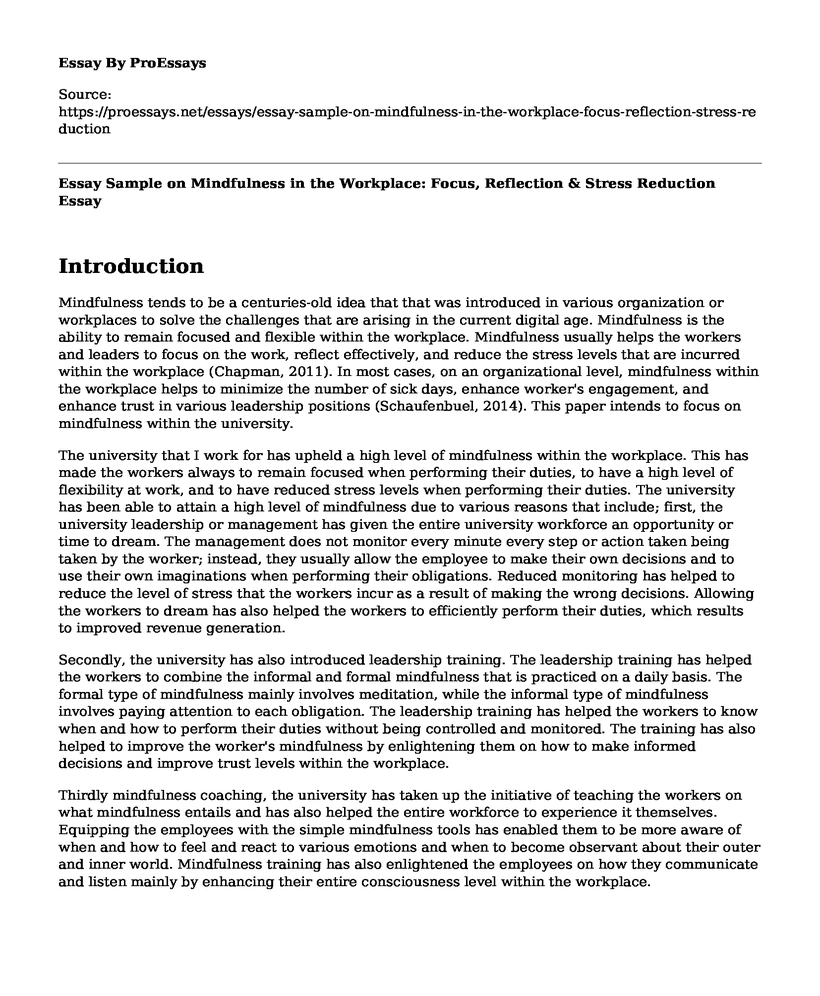Introduction
Mindfulness tends to be a centuries-old idea that that was introduced in various organization or workplaces to solve the challenges that are arising in the current digital age. Mindfulness is the ability to remain focused and flexible within the workplace. Mindfulness usually helps the workers and leaders to focus on the work, reflect effectively, and reduce the stress levels that are incurred within the workplace (Chapman, 2011). In most cases, on an organizational level, mindfulness within the workplace helps to minimize the number of sick days, enhance worker's engagement, and enhance trust in various leadership positions (Schaufenbuel, 2014). This paper intends to focus on mindfulness within the university.
The university that I work for has upheld a high level of mindfulness within the workplace. This has made the workers always to remain focused when performing their duties, to have a high level of flexibility at work, and to have reduced stress levels when performing their duties. The university has been able to attain a high level of mindfulness due to various reasons that include; first, the university leadership or management has given the entire university workforce an opportunity or time to dream. The management does not monitor every minute every step or action taken being taken by the worker; instead, they usually allow the employee to make their own decisions and to use their own imaginations when performing their obligations. Reduced monitoring has helped to reduce the level of stress that the workers incur as a result of making the wrong decisions. Allowing the workers to dream has also helped the workers to efficiently perform their duties, which results to improved revenue generation.
Secondly, the university has also introduced leadership training. The leadership training has helped the workers to combine the informal and formal mindfulness that is practiced on a daily basis. The formal type of mindfulness mainly involves meditation, while the informal type of mindfulness involves paying attention to each obligation. The leadership training has helped the workers to know when and how to perform their duties without being controlled and monitored. The training has also helped to improve the worker's mindfulness by enlightening them on how to make informed decisions and improve trust levels within the workplace.
Thirdly mindfulness coaching, the university has taken up the initiative of teaching the workers on what mindfulness entails and has also helped the entire workforce to experience it themselves. Equipping the employees with the simple mindfulness tools has enabled them to be more aware of when and how to feel and react to various emotions and when to become observant about their outer and inner world. Mindfulness training has also enlightened the employees on how they communicate and listen mainly by enhancing their entire consciousness level within the workplace.
Recommendation
Despite the university having achieved quite an excellent level of mindfulness within the workplace, the institution still needs to implement other strategies that are also efficient and effective in enhancing worker mindfulness. Some of these strategies include introducing the mindfulness micro-practices; the workers who undergo a meditation program should continue practicing using various micro-practices that enable them to master the art of mindfulness completely (Hunter & McCormick, 2008). Secondly, allowing the workers to take a break from their workstations. Implementing this strategy will help to create a shift in both physical and mental activity. This shift also helps to create room for rest and rejuvenation.
Conclusion
Mindfulness tends to be an idea that helps the workers to remain flexible and focused when performing their duties. The university I work for has been able to attain a high level of mindfulness as a result of implementing various strategies that include; first, the university has implemented leadership training. Secondly, they also undertake mindfulness coaching. Thirdly, the institution has given the workers an opportunity to dream.
References
Chapman, M. (2011). Mindfulness in the workplace: what is all the fuss about. Counseling at Work, 20-4. http://citeseerx.ist.psu.edu/viewdoc/download?doi=10.1.1.475.8989&rep=rep1&type=pdf
Hunter, J., & McCormick, D. W. (2008). Mindfulness in the Workplace: An exploratory study. In SE Newell (Facilitator), Weickian Ideas. Symposium conducted at the annual meeting of the Academy of Management, Anaheim, CA. http://www.mindfulnet.org/Mindfulness%20in%20the%20Workplace.pdf
Schaufenbuel, K. (2014). Bringing mindfulness to the workplace. UNC Kenan-Flagier Business School. http://affinityhealthhub.co.uk/d/attachments/bringing-mindfulness-to-the-workplace-1498492995.pdf
Cite this page
Essay Sample on Mindfulness in the Workplace: Focus, Reflection & Stress Reduction. (2023, Mar 25). Retrieved from https://proessays.net/essays/essay-sample-on-mindfulness-in-the-workplace-focus-reflection-stress-reduction
If you are the original author of this essay and no longer wish to have it published on the ProEssays website, please click below to request its removal:
- Stress Management Amongst Adolescents
- Autism Spectrum Disorder in Children Research Example
- Patients Psychiatry Interview Example
- How Do Interdependent Communities Differ in Suicide Rates Versus Independent Communities?
- Paper Example on Attracting, Retaining, & Training Nurses in Rural Areas: An Evaluation
- Bipolar Disorder: Historical Background, Causes, Symptoms & More - Research Paper
- Essay Sample on Discovering My Career Path: A Journey from China to Canada







